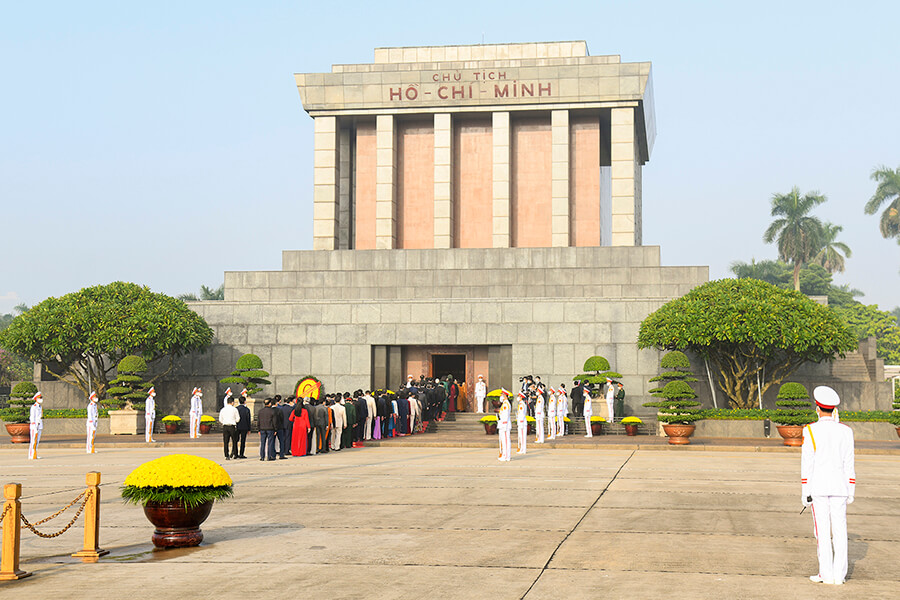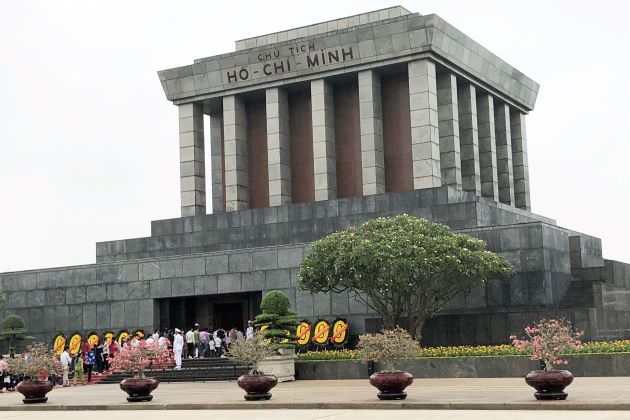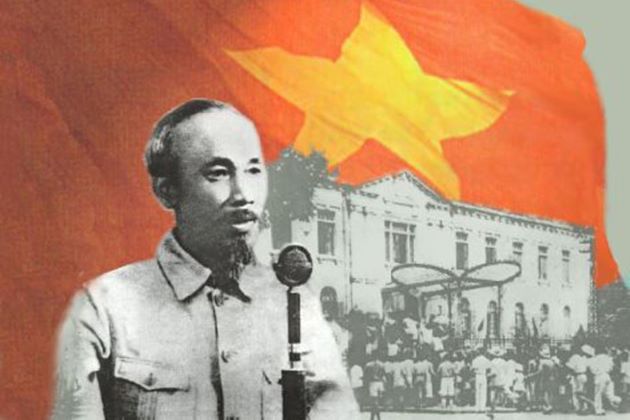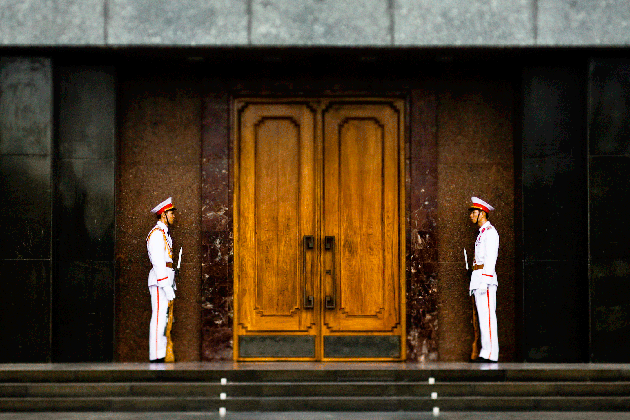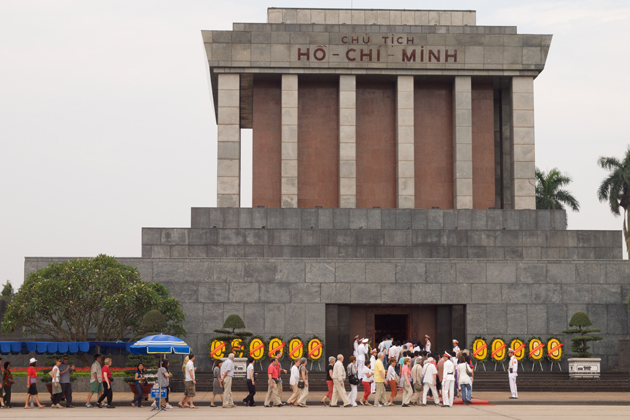The Mausoleum of Ho Chi Minh in Hanoi, Vietnam is the ultimate resting place of modern Vietnam’s Great Father, Ho Chi Minh. A large, solemn building rises above the quiet Ba Dinh Square – Ho Chi Minh Mausoleum marked the history of a great leader, Chairman of Vietnam Communist Party (1951-1969), who read the Declaration of Independence on 2 September 1945, establishing the Democratic Republic of Vietnam.
Brief Information of President Ho Chi Minh
Originally named as Nguyen Sinh Cung but later changed his name to Nguyen Tat Thanh, Nguyen Ai Quoc and then Ho Chi Minh, the Vietnamese Communist Revolutionary Leader was the prime minister (1945–1955) and the president (1945–1969) of the Democratic Republic of Vietnam (North Vietnam).
He was the man behind the Viet Minh Independence Movement from 1941 onward, leading to the foundation of the Communist-government Democratic Republic of Vietnam in 1945. Ho Chi Minh was a legendary military mastermind, proved by his defeating the French Union in 1954 at the glorious battle of Dien Bien Phu. Due to health problems, he retired from office in 1965, but his figure as the great inspiration for Vietnam’s independence movement remained visible. Just when the Vietnam war was awaiting its final peak, Ho Chi Minh passed away at 09:47 on the morning of 2 September 1969 from heart failure at his home in Hanoi, aged 79.
The Construction of Ho Chi Mausoleum
History of Uncle Ho's Mausoleum
The construction of the Mausoleum began in September 1973 and came to the final stage in August 1975. In his will, the President asked to be cremated and has his ash buried on the hills of the North, the Center, and the South of Vietnam. However, in compliance with the wish of the Vietnamese people and in honor of his dedication to the country, the successor government decided to remain his body. Hence, the project of building the Mausoleum and surrounding complex was proposed.
Nevertheless, during that time, the Vietnam war was at its tough turning point and the project had to be halted. The president’s body was kept in a secret aseptic environment, waiting for a peaceful day soon to come. Since 1969, the Mausoleum was opened but due to a lot of hardship occurring (wars, bombing, natural disasters), it was years before his body was officially placed into the Mausoleum.
Popular Sectors in the Ho Chi Minh Mausoleum
The Mausoleum of Ho Chi Minh is but one section lies within the Ho Chi Minh complex, including the Mausoleum of Ho Chi Minh, the Ba Dinh Square, the Ho Chi Minh Museum, the Presidential Palace, Ho Chi Minh Residence, and the One Pillar Pagoda. The Complex was listed in the top 25 Special National Relics is a valuable testimony to the former life of President Ho Chi Minh.
External Design of Uncle Ho's Mausoleum
The granite mausoleum resembles Lenin’s Tomb in Moscow, yet the layout and design clearly reflect the culture and lifestyle of Vietnam. Equipment for infrastructure was imported from the Soviet Union, but Vietnamese experts had to alter the materials a lot to adapt to the tropical climate and condition in Vietnam.
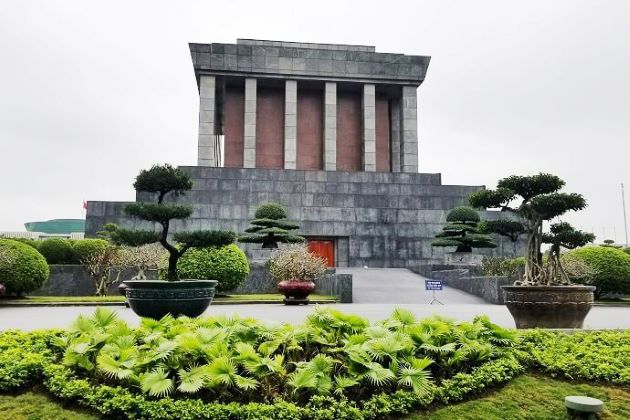
The structure is 21.6 meters (70.9 feet) high and 41.2 meters (135.2 feet) wide. Grey granite made up the external design, while the interior is dominated by grey, black, and red polished stone. The words “Chu tich Ho Chi Minh” (President Ho Chi Minh) were inscribed on the Mausoleum’s portico, while the slogan “Nuoc Cong Hoa Xa Hoi Viet Nam Muon Nam” (State of the Socialist Republic of Vietnam Forever) is on the banner beside.
Internal Design of the Ho Chi Minh Mausoleum
Inside, the embalmed body of President Ho Chi Minh is kept in a cool, central hall, guarded by an honored officer. The hall is quite dark and the body is protected by a glass case, in dim lights. Every week, there are hundreds of visitors showing to pay their respects at the mausoleum. Visitors have to keep their legs covered, be silent, and walk-in two lines. Hands must not be in pockets or crossed. Smoking, eating, photo taking, and videotaping are also strictly forbidden.
Highlights of Ho Chi Minh Mausoleum
Ho Chi Minh Mausoleum is a sacred place of significant historical value and is definitely a must-visiting destination for any tourist to Hanoi city. Below are the highlights of the relic that beckons visitors:
- The Mausoleum is very well-maintained and has an overpowering presence with a lot of historical colors attached to it. The site is an eloquent testimony to the history of a great leader and his small yet intrepid nation. Visitors will have the chance to observe proof of the victory against invaders in the Colonial Era that the Vietnamese are so proud of.
- Ho Chi Minh Mausoleum has an air of holiness and sovereignty that visitors can easily emerge to it. Everyone visiting the Mausoleum shows a reverential and respectful attitude. International tourists can easily see how Vietnamese people respect their Great Uncle Ho and how the formality of a visit to the Mausoleum is strictly maintained. This will be a totally different experience from a trip to any other tour destinations.
- Tourists can spend their day discovering not only the Mausoleum but also the surrounding complex. The Ba Dinh Square, the Ho Chi Minh Museum, the Presidential Palace, Ho Chi Minh Residence, and the One Pillar Pagoda are other captivating sections in the Ho Chi Minh Complex. All places are well-preserved and guarded with meticulous care, where the legends of the proud leader are ready to be told by the willing tour guides.
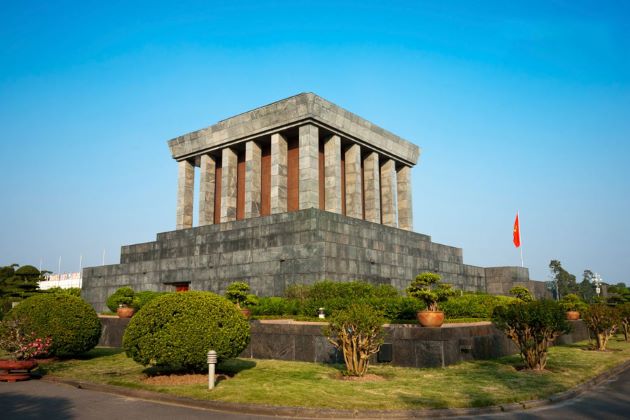
Ho Chi Minh Mausoleum Travel Guide
How to Get to the Ho Chi Minh Mausoleum
Ho Chi Minh Mausoleum is located on Hung Vuong Street, Ba Dinh District, Hanoi. The Mausoleum is accessible by both private and public transportation. For private transportation users, parking is available at the Ong Ich Khiem road, in front of the Ho Chi Minh Protection High Command building and the Ngoc Ha road, at the entrance gate of the Ho Chi Minh Museum. Buses number 09, 34, 22 all offer a stop at the Le Hong Phong Road, just less than minutes walk to the Mausoleum.
Entrance Fee - Opening Hours - Dresscode
- The Mausoleum is open on all day of the week with the exception of Monday and Friday (Tuesday - Thursday 07:30 - 10:30, Saturday & Sunday 07:30 - 11:00)
- Both domestic and international tourists are offered free entrance fee to the Mausoleum
- Dress code: Formal
- Entrance Fee: VND 40,000 (Tickets at 25 Hung Vuong Street)
Ho Chi Minh Mausoleum will absolutely leave your Hanoi day tours as well as Vietnam vacation packages unforgettable memories.

